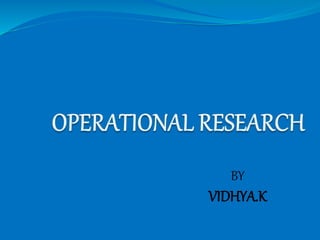
Operational research queuing theory
- 1. BY VIDHYA.K
- 3. INTRODUCTION: A flow of customers from finite/infinite population towards the service facility forms a queue on account of lack of capability to serve them all at a time. Queues (or) waiting lines are very common in everyday life. In the absence of a perfect balance between the service facilities and the customers, waiting time is required either for the service facilities (or) for the customer’s arrival.
- 4. EXAMPLE: We often face the problem of long queues for a bus, a movie ticket, etc... We generally see long queues in front of railway booking offices, bank counters, post offices, etc.. In those days. We also find automobiles waiting at service stations, likewise Patients waiting for doctors, etc..
- 5. COMMONLY USED TERMS IN QUEUING THEORY: CUSTOMER: customers may either be a person or a machine or other items which is arrived to avail some service. SERVICE STATIONS: it is a point where service is provided. It can be one or more service stations. WAITING TIME: the time that the customer spends in the queue before being serviced. TIME SPENT BY A CUSTOMER IN THE SYSTEM: It is equal to the waiting time of customer plus the service time.
- 6. CONTINUED..... NUMBER OF CUSTOMERS IN THE SYSTEM: It is equal to the sum of number of customers in queue and the number of customers being served. QUEUE LENGTH: number of customers waiting in the queue comprises the queue length. JOCKEYING: joining the other queue and leaving the first queue. RENEGING: joining the queue and leaving it afterwards.
- 7. Continued... BALKING: customers decides not to join the queue. QUEUEING SYSTEM: it is the system consisting of arrival of customers, waiting in queue, picking up for service according to a certain discipline, being serviced and departure of customers.
- 8. ELEMENTS OF QUEUING SYSTEM: The input(arrival pattern), The service mechanism(service pattern), The queue discipline and Output of the queue.
- 9. The input(arrival pattern): The input describes the way in which the customers arrive and join the system. We cannot predict the arrival time of customers randomly. It is characterised by its: size, arrival time distribution of customers, mean time between intervals, attitude of the customers. Mean time is often represented by Greek letter λ known as LAMBDA. Mean time between arrivals is represented by 1/λ .
- 10. SERVICE MECHANISM: This means the arrangement of service facility to serve the customers. If there is infinite number of servers then all the customers are served instantaneously on arrival, and there will be no queue. If the number of servers are finite then the customers are served according to the specific order with service time a constant or a random variable. The average number of customers being served in one unit of time at a service station is often denoted by the Greek letter μ. Average time taken to service a customer is represented by 1/μ.
- 11. QUEUE DISCIPLINE: It is a rule according to which the customers are selected for the service when a queue has been formed. The common disciplines are: FIRST COME FIRST SERVED (FCFS) FIRST IN FIRST OUT (FIFO) LAST IN FIRST OUT (LIFO) SELECTION FOR SERVICE IN RANDOM ORDER (SIRO).
- 12. OUTPUT OF THE QUEUE: Generally this factor is not important but in some cases it may influence the service/arrival rate. For example: if there is only one door to service point through which people enter and leave after being served, it is possible that people leaving could affect the rate of arrival.
- 13. THANK YOU
